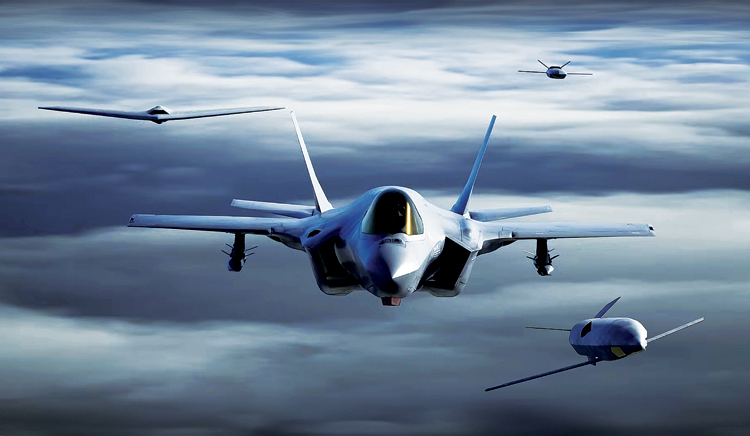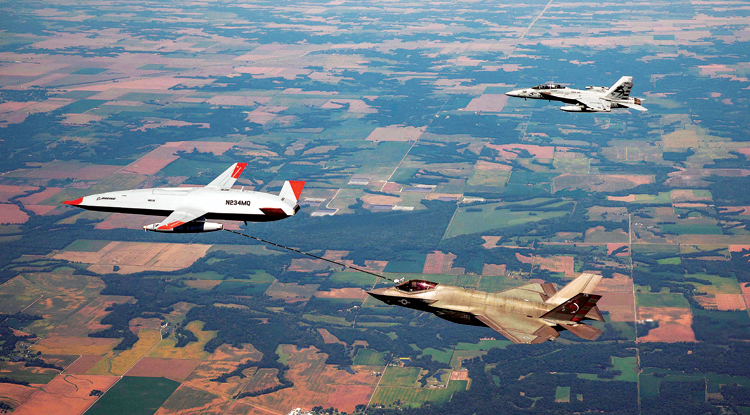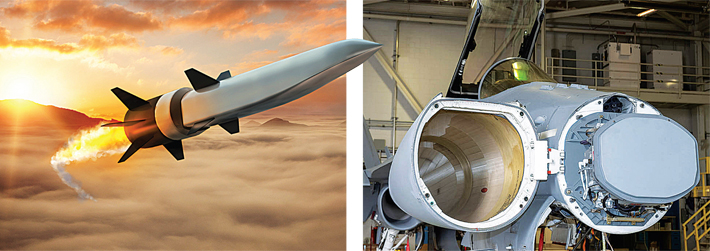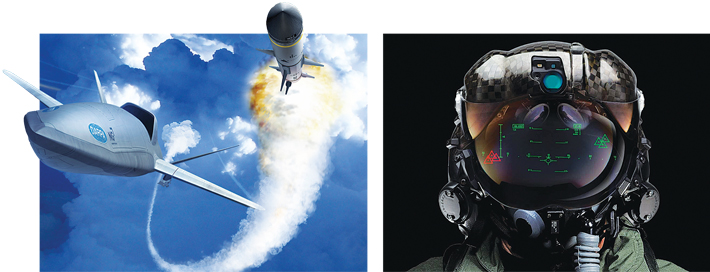INDIAN ARMED FORCES CHIEFS ON OUR RELENTLESS AND FOCUSED PUBLISHING EFFORTS

The insightful articles, inspiring narrations and analytical perspectives presented by the Editorial Team, establish an alluring connect with the reader. My compliments and best wishes to SP Guide Publications.

"Over the past 60 years, the growth of SP Guide Publications has mirrored the rising stature of Indian Navy. Its well-researched and informative magazines on Defence and Aerospace sector have served to shape an educated opinion of our military personnel, policy makers and the public alike. I wish SP's Publication team continued success, fair winds and following seas in all future endeavour!"

Since, its inception in 1964, SP Guide Publications has consistently demonstrated commitment to high-quality journalism in the aerospace and defence sectors, earning a well-deserved reputation as Asia's largest media house in this domain. I wish SP Guide Publications continued success in its pursuit of excellence.
The Future of Aerial Combat
The battle skies of tomorrow will be shaped and decided by pioneering technologies in aerial warfare

Military aviation and space have seen the fastest evolution. Air power played a significant role in Korea and Vietnam. Arab-Israeli and Indo-Pak wars saw conventional peerlevel operations and gave out solid lessons. Iraq and Afghanistan were uncontested battlegrounds. And now Ukraine, Hamas, and Houthis have driven importance of cheaper drones and air defence systems. Clearly aerial technologies and their impact are reshaping the future wars.
The last century has seen aerospace becoming the most preferred means of prosecution of war. The continued need for air and space superiority to allow favourable prosecution of air, surface and sub-surface operations remains underscored. The combat aircraft have become more agile with characteristics of high speed and manoeuvrability, delivered with greater efficiency. Aerial platforms have become stealthier, and support low-observable sensors are able to see and sense farther. Aircraft can carry and deliver very long-range air-to-air and air-to-surface precision weapons. The aircraft’s ability to operate in an intense electronic warfare environment has increased.
The next generation UAS will be able to take on IST, surface strike, air defence, aerial refuelling, and air delivery
Fighter aircraft attributes such as very high speed and manoeuvrability will be less important compared to range and precision of sensors and weapons. Integrated sensors across platforms coupled with secure datalinked communications have allowed the system of systems approach. Artificial Intelligence (AI) supports speedier decision-making.
NEXT GENERATION FIGHTERS
The next generation aircraft have to be designed for a highly contested and well-defended environment. The combat engagements will be at very long ranges. Platforms that “seeing first, shooting first, and destroying first”, and yet are survivability. They will be multiple-role, and carry weapons for both air-to-air and air-to-surface targets. Aircraft should be able to act as mother-ships or controllers in a manned-unmanned teaming mix. Aircraft will be closely integrated and securely data-linked with other platforms in the air or on the surface.
Artificial Intelligence (AI) will support aircrew’s cockpit housekeeping chores, and generate weapon firing solutions. “Data-to-decision” (D2D) capability will be crucial. Humanmachine interface will improve greatly. All hemisphere situational awareness will allow more comprehensive threat assessments and response options. Futuristic avionics will include agile advanced electronically scanned array (AESA) radars, and passive data-linked sensors. Aeroengines will be flight phase adaptive, more fuel-efficient, and feature thrustvectoring, and in-built super-cruise. Stealth will be inbuilt in the airframe design through advanced shaping and skin layering techniques using composite materials, without adding weight, or trading in flight performance. Engine inlet and exhaust will be designed for low radar-cross section (RCS) over the entire spectrum of frequencies.

The conformal weapon bays will carry very long-range weapons. Weapons will have increased degree of post-launch autonomy. Enhanced on-board power generation will support powerful electronic warfare systems and DEWs. The aircraft will incorporate preventive maintenance tools, and online health monitoring and diagnostics, with inbuilt structural self-healing materials.
Some technologies may sound weird, such as sweat powered electricity, touch hear text recognition, solar power generating canopies, sub-dermal nutrients, adaptive camouflage or “quantum stealth”, magnetic flux generator to fire projectiles (coil guns), selfsteering smart guided bullets, among many other technologies.
AERIAL WEAPONS AND SELF-PROTECTION
Future missiles will have long range detection, cruise farther and have high no escape zones. All countries are pushing advanced hypersonic weapon programmes. The US Air Force, along with Raytheon, is working on a mini-missile that can shoot down incoming air-to-air and surface-to-air missiles as part of the Miniature Self-Defence Munition (MSDM) programme.
New turret systems will allow high-energy lasers to engage enemy aircraft and missiles. Stand-alone high-energy laser weapon pod for being designed. The US Air Force Research Laboratory (AFRL) is developing a fibre laser system called Selfprotect High Energy Laser Demonstrator, or SHiELD. It could daze or burn electronics of other airborne platforms. Hypersonic cruise missiles (HCMs) have already been used in combat in Ukraine. Hypersonic Glide Vehicles (HGVs) and HCMs will bring game-changing vulnerabilities to strategic targets and large ships and aircraft carriers. Large platforms like the Airborne Early Warning and Control (AEW&C) and Flight Refuelling Aircraft (FRA) will kept farther away from tactical area by long-range missiles.
India’s Astra Mk-1 (110 km) AAM is operational. Mk-2 (160 km) is under development. The very long range (VLRAAM) Mk-3 will have range over 300 km. The air-launched BrahMos missile (500 km) has been integrated on the Su-30 MKI. Longer range variants are evolving. The hypersonic version, BrahMos-II, begin testing in 2024. The later variant will have ranges up to 1,500 km. DEWs are work-in-progress.

(RIGHT) AN/APG-79 AESA RADAR
UNINHABITED AERIAL SYSTEMS (UAS) AND COUNTERS
Drones and uninhabited systems are already flying in large numbers. Optionally manned aircraft are evolving. Autonomous UAS are operating from aircraft carriers. The next generation UAS will be able to take on IST, surface strike, air defence, aerial refuelling, and air delivery. By the mid-2040s, it is envisaged that every aerial mission could be flown unmanned. Aerial drone swarms have been repeatedly demonstrated, including by Indian manufacturers. Swarms could overwhelm defences by sheer numbers. Drone counters using small arms, electro-optical weapons (laser), data-link jamming, electronic or cyberattack, are evolving. A drone swarm may be engaged by a counter-drone swarm.
Future missiles will have long-range detection, cruise farther and have high no escape zones
Manned and unmanned aircraft teaming (MUM-T) will exploit the advantage of the human in the loop with the strength of numbers to take on well-defended target systems. A large number of Indian companies are engaged in UAV and drone manufacture. Hindustan Aeronautics Limited (HAL) is working on Manned, unmanned teaming (MUM-T).
LARGER VS SMALLER PLATFORMS
Larger platforms have the advantage of longer range and larger quantum of armaments, including very long-range larger missiles. They have the advantage of a greater power source required for DEWs and electronic warfare equipment of the future. Since manoeuvrability will not be crucial for BVR engagements, lack of agility will not be a disadvantage. Large aircraft stealth is already here. Large aircraft will be better suited for MUM-T. Of course, they will be costlier to acquire and maintain. The smaller aircraft have the advantage of being cheaper and agile. A mix of the two types will be required.
LONG ENDURANCE, LONG-RANGE MISSIONS
Humans have to prepare for long-range, long-endurance operational missions that will involve weapon delivery and aerial engagements. Smart drugs and hybrid supplements increase endurance, stamina, physical strength, and alertness levels, and regulate the sleep and waking hours, and pilots could keep awake for days.
AIRBORNE RADARS IN HIGH ECM ENVIRONMENT
Modern AESA radars will require to operate in heavy Electronic Counter-Measures (ECM) environments. In order to reduce the size, weight, power consumption, and cost of AESA radars, small computer-controlled solid-state transmit/receive modules (TRMs) are put together in an array, using multiple-input multiple-output (MIMO) technology. AESA’s beam forming and steering agility will permit better tracking of very fast supersonic cruise missiles and aircraft. AESA radars are also used in missiles for the same reason. To reduce spectrum congestion many applications have moved beyond 20 GHz. Millimetre wave radars can give much better resolution because of ultra wide bandwidths, and lower ground clutter, and they also give the benefit of smaller size. Gallium Nitride (GaN) power transistors can operate at higher power levels and higher frequencies, more efficiently. Future radars will have lower power sectorial emissions and, thus, would be electronically stealthy. India’s Uttam AESA radar is evolving well.

(RIGHT) F-35 GEN-III HELMET MOUNTED DISPLAY SYSTEM (HMDS).
PASSIVE SENSORS
Passive systems like the Infra-Red Search and Track (IRST) do not radiate, as such, don’t expose own location, and are considered counter-stealth technology. But IR systems are susceptible to weather and atmospheric phenomena. The detection range are currently much lower than radar, at maximum around 100 km. The new concept is to have a universal podded IRST that gives flexibility to match the sensors to the mission quickly. Future high-precision sensors will be more sensitive, use advanced image processing technology and advanced display systems, and pick up weaker signals from farther distances. Dual-band systems are optimised for different ranges. New generation IR detectors are based on Quantum Wall IR Photo-detectors (QWIP) that can sense much less IR energy contrast. Multiple Aperture IR (MAIR) will mean many IR sensors around the aircraft for all-hemisphere detection. It will also act as missile warner.
HIGH MISSION TURNAROUND: AIRCRAFT DIAGNOSTICS AND REPAIR
High mission rates are possible through better online aircraft health monitoring. Real-time aircraft systems data is connected to the fleet data bases through Wi-Fi or Satellite communications. The systems are combined sophisticated data processing systems. They incorporate fault diagnostics using AI. Technology will allow predictive maintenance solutions. Online real-time monitoring reduces turn-around maintenance time, and improves aircraft utilisation rate. It could, in the long run, reduce the ‘life cycle cost’.
AI will support aircrew’s cockpit housekeeping chores, and generate weapon firing solutions
With greater usage of composite, self-healing materials, repairs have become possible and save time. A pocket of epoxy resin and a hardener could be installed near pre-assessed vulnerable parts of the aircraft airframe, and released automatically or manually released to fix the damaged part. Robots will support aircraft inspection and maintenance tasks. Newer systems have redundancies and designed for low meantime between failures (MBTF) to ensure maximum airtime and minimum logistics requirements.
AIRCRAFT ENGINE TECHNOLOGY
Future engine technologies must support a reduced development cycle, reduce engine weight, improve engine propulsive efficiency and better Specific fuel consumption (SFC), improve reliability and maintainability, and reduce life the cycle costs. New materials will be lighter and withstand higher temperatures. Better turbines machining will also reduce weight and blade balance. The carbon-fibre blades are being used. Full computer controlled “smart engines” and use of magnetic bearings, will also improve engine operations. Additive 3D manufacture will reduce production time and cost. It will also reduce maintenance time. The variable cycle engine will select the high-thrust mode when maximum power is required, and high-efficiency mode during cruise, for fuel savings and best range. New engines will use advanced adaptive versatile engine technology for longer ranges and higher performance. Bio-fuels will be increasingly used. The future will see increased use of electrical power for aircraft propulsion and various subsystems. Hybrid-electric aircraft are already evolving.
Developing an indigenous aero-engine is a core area for India’s ‘Atmanirbharta in defence’. DRDO’s Gas Turbine Research Establishment (GTRE) has struggled to make a turbojet engine for many decades. There are handful of global manufacturers who do not easily part with technology. Joint ventures (JV) are the best option forward for India. It must exploit large domestic market. Even if it costs money, India must have intellectual property rights (IPR) over the engine. Small engines are also required for cruise missiles and UAVs. India must also invest in electric and hybrid engines.
COMMUNICATIONS AND ELECTRONIC TECHNOLOGIES
5G and 6G telecommunications networks will be crucial for aviation design and on-board data handling. They will also be crucial for satellite and ground-based communications. This will also involve the beaming of millimetre length microwaves at the earth from thousands of new communication satellites. These speeds will also be required for cyber security. Imported electronic hardware of the aircraft could be a high-risk with embedded chips. Indigenisation is very important. Similarly, the electronic warfare equipment has to the home-developed. Microchips are required for aircraft, automation, electro-optical systems, including the weapon sensors. India has decided to invest large sums in their manufacture. 5G will be required for network-centred warfare. Secure, jam-proof data-links will be required for UAS and drone swarms.
MODERN COCKPIT TECHNOLOGIES AND CONCEPTS
Most aircraft already have “glass cockpits.” The electronic display screens are reconfigurable. Most traditional controls are being replaced by multifunction “soft keys”. “Hands on Throttle and Stick” or HOTAS controls have got refined. Head-Up Displays (HUD), Helmet mounted sighting system and the Direct Voice Input (DVI) reduce the pilot’s head-down work. Projections are also being made on cockpit canopies. Virtual retinal displays (VRD) are also evolving.
Composite materials are lighter and stronger are being extensively used in aerial platforms, including in India
CRITICAL AIRFRAME TECHNOLOGIES
Composite materials are lighter and stronger are being extensively used in aerial platforms, including in India. Wing body blending is being taken to next level. Flexible aerofoil concepts are evolving. Adaptive-curvature wings will be the future, and will allow changing the wing profile during flight. Actuators and sensors will be used to create computed wing deformations. The wing will not require the traditional control surfaces. Stealth designs will evolve further.
DATA FUSION, ARTIFICIAL INTELLIGENCE AND CYBER SECURITY
The demand for streaming high-quality data requires bandwidth, which involves innovating sensor/processing systems. The data fusion will be deepened by integrating sensors on different platforms, including satellites and drones. Networkcentric payload processing units enable on-board data fusion prior to sending to digital links. AI will support aircraft systems management and determine which data should be presented to the pilot. Sensor fusion and optional-manning, would mean heavy reliance on data-links and networks. The sixth-generation avionics will have to be resilient to jamming and have the capability to jam adversary systems.
AUTOMATION SAFETY ISSUES AND MANAGEMENT
Automation in modern cockpits supports many flight assist features. It helps reduced-visibility take-offs, and landings. It also supports multiple systems monitoring, failure alerts, and suggests remedial pilot actions. Automation also assists system health diagnostics. It also relieves pilots from boring repetitive tasks and allows crucial parameter monitoring. The negative fallouts of automation is over dependence and results in declining pilot flying skills. Automatic system disengagement due to a failure state may be missed by the aircrew and have adverse consequences. Unanticipated situations requiring manual override of automation can induce peaks of workload and stress. Automation dependency, inadequate systems knowledge and a lack of manual flying and aircraft management competence could be a deadly cocktail combination, requiring attention.
TECHNOLOGY IMPACT SUMMARY
Robotics and AI will make a huge difference in the times to come. As militaries keep driving technologies, the future will involve more wireless systems. Future warfare will increasingly be through uninhabited systems. Lighter, longer lasting batteries will greatly support automation. Tele-presence will support single-pilot operations, and, along with AI it will keep enhancing decision-making. AI will also support actions to prevent catastrophic events or accidents. 360 degree virtual-reality systems will help improve situational awareness. 6G technologies will make things even faster, which will be crucial for the large volume of data exchange. There will be much improved cloud-based voice “Alexa” type service. Increasing unmanned urban air mobility will seek navigation and traffic safety solutions. Miniaturisation will continue in more areas. Sensors and weapons ranges, and precision will increase further.
Some of the key technologies will include development and manufacturing of nano-scale, smart meta-materials, and advanced composites. Special coatings will require high-specification machine processes. Some critical minerals will be required for future materials. Platforms will use advanced magnets and superconductors.
Additive manufacturing will grow. AI will influence all aerial technologies, and support hardware accelerators. High performance computing and communications technologies will see more applications. Advanced data analytics and machine learning excellence will evolve. Cyber security will be critical. Advances in hydrogen and other hybrid fuels, and electric batteries will matter. Nuclear energy could one day power aerial platforms. Quantum computing and cryptography applications will evolve. Hypersonic flight and weapons will advance. Drones, swarming and collaborative robots will be used extensively.
India must get into the act, lest it gets left behind!





